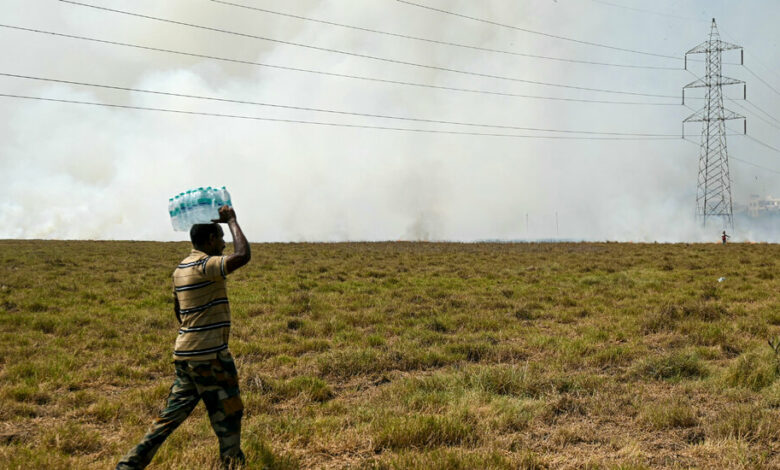‘Hanging by a thread’: UN chief warns of missing key climate target

With the planet gripped by the highest temperatures in more than 100,000 years, scientists at the United Nations weather agency have crunched the numbers and come to a grim conclusion: More record-breaking hot years are all but inevitable.
Over the next five years, there is a nearly 90 percent chance that Earth will set another record for its warmest year, surpassing the scorching highs of 2023, the World Meteorological Organization says. a report Wednesday.
It is almost equally likely that in at least one of those five calendar years, the average global temperature will be 1.5 degrees Celsius or 2.7 degrees Fahrenheit higher than it was at the start of the industrial era. That is the level of warming that countries under the 2015 Paris Agreement wanted to avoid.
“The goal of limiting long-term global warming to 1.5 degrees Celsius is hanging by a thread,” United Nations Secretary-General António Guterres said Wednesday in a speech at the American Museum of Natural History in New York City. He called for urgent action in a number of areas, including cutting carbon emissions and adopting renewable energy, helping poor countries finance their climate plans and curbing the fossil fuel industry.
On the latter topic, Mr. Guterres reiterated previous calls for an end to taxpayer subsidies for oil and gas. But he also turned his attention to a new target: He urged governments to ban advertising by fossil fuel companies, comparing oil and coal producers to the tobacco industry, which faces advertising restrictions worldwide. And he urged the news media and technology companies to stop running their ads.
“Fossil fuels aren’t just poisoning our planet; they are toxic to your brand,” Mr. Guterres said, referring to advertising and PR agencies. “I call on these companies to stop acting as catalysts for planetary destruction.”
Several publications, including The Guardian newspaper, have stopped accepting fossil fuel ads. The New York Times accepts ads from oil and gas companies with some restrictions, including a ban on sponsoring its climate newsletter and climate events, a company spokesperson said. The Times also won’t let fossil fuel companies buy all the ad spots in individual episodes of its podcast “The Daily.”
The latest period of record-breaking warmth on Earth began in the middle of last year and continues as summer approaches the Northern Hemisphere.
Last month was the world’s warmest May on record, the European Union’s Copernicus Climate Change Service announced on Wednesday. That made it the twelfth month in a row in which average global temperatures surpassed all previous records for the time of year. According to Copernicus, the mercury during that twelve-month period was on average 1.63 degrees Celsius warmer than during the pre-industrial era.
The Paris Agreement states that the 1.5 degree target is a ‘long-term goal’. Technically, this means that the world will only succeed in enforcing the pact if temperatures exceed the threshold for many years, even decades, and not just one year.
“Temporary exceedances do not mean that the 1.5 target is permanently lost,” Ko Barrett, the deputy secretary general of the World Meteorological Organization, said at a news conference. But what now seems clear, she added, is that such exceedances will become increasingly common.
The effects of the abnormal heat are being felt around the world. In India and other parts of South Asia, temperatures have risen well above 110 degrees Fahrenheit in recent weeks, pushing many people to the brink. Millions of Americans in California, Nevada and Arizona are experiencing their first intense heat wave of the season this week.
Recent floods in Brazil have caused widespread death and destruction and could become the country’s costliest disaster ever. The multi-day torrential rains that caused the floods were made twice as likely by extra heat energy added to the atmosphere by human activity, scientists said this week.
Coral reefs around the world are suffering the most widespread bleaching ever recorded, largely because of how warm the water has been. The National Oceanic and Atmospheric Administration expects this year’s Atlantic hurricane season to be exceptionally stormy, with 17 to 25 named tropical cyclones. Record ocean temperatures, which provide the thermodynamic fuel for storms to form and intensify, are a major factor.
As global warming continues, “this series of warmest months will be remembered as relatively cold,” said Carlo Buontempo, director of Copernicus. By quickly reducing greenhouse gas emissions, the Earth could cool back to today’s temperatures by the end of the century, he said.
There is at least one reason to believe that temporary relief is on the way. El Niño, the natural climate phenomenon, is fading. During periodic El Niño events, huge amounts of heat are redistributed across the Pacific Ocean, leading to shifts in global weather patterns that typically cause the planet as a whole to warm. This has contributed at least in part to the record temperatures of 2023.
Other contributors may stick around longer. In a study In a report published last week, a team of scientists led by Tianle Yuan, a geophysicist at the University of Maryland in Baltimore County, estimated that the planet may be warming for an illogical reason: recent regulations that have dramatically curbed air pollution from ships.
Burning fuel oil releases carbon dioxide, which warms the planet, but it also releases sulfur compounds that can have a modest opposite effect. Once in the atmosphere, these compounds transform into particles that help cool the world, either by reflecting sunlight back into space or encouraging the formation of more clouds.
These pollutants continue to harm human health and ecosystems, which is why the International Maritime Organization has set new limits on sulfur emissions from ships starting in 2020. But in doing so, the agency may have inadvertently contributed to the Earth being slightly warmer than it otherwise would have been, Dr. Yuan and his colleagues estimate.
To scientists, the main driver of the warming remains clear: atmospheric levels of carbon dioxide, methane and nitrous oxide, the three main human-made heat-trapping gases, have continued to rise. steady climb up. At current emissions rates, it may only take about five years for humans to change the chemistry of the atmosphere so drastically that it will be extremely difficult to prevent warming from exceeding 1.5 degrees Celsius, scientists estimate.




